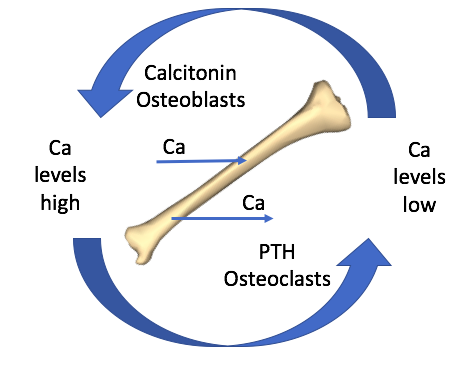In this lesson you will explore how and why bones undergo the process of remodeling. Specifically, this lesson will cover:
1. Bone Remodeling
Bone remodeling is the process bones constantly undergo of taking away and building tissue. This process is controlled by mechanical stress and hormonal negative feedback loops. Negative feedback is when there is a change that is sensed by the body, and that change is then reversed. Certain levels of calcium in the blood are needed for your nervous and muscle systems to function properly; bone remodeling is the process of recycling calcium to maintain proper levels in your blood.
Two types of cells in your bones play an important role in the bone remodeling process:
-
Osteoblasts: Cells found in bones that build bone tissue by secreting collagen into bone tissue spaces. The collagen binds to calcium and forms the tough tissue within bones. These cells are found in the periosteum of bones.
-
Osteoclasts: Cells found in bones that secrete hydrochloric acid to break down the bonds between calcium and collagen. The calcium is then released from bone.
-
-
- Bone Remodeling
- The process bones constantly undergo of taking away and building tissue; is controlled by mechanical stress and hormonal negative feedback loops.
-
- Osteoblast
- A cell that builds bone tissue by secreting collagen fibers that bind to calcium; this combination forms the tough tissue matrix of bone.
-
- Osteoclast
- A cell that breaks down bone tissue by secreting hydrochloric acid into the tissue spaces; dissolves the bond between calcium and collagen.
2. The Role of Hormones
The process of bone remodeling is signaled by hormones—either the hormone PTH or Calcitonin. Depending on whether there's too much or too little calcium in the blood, one of those hormones is going to have a role in helping to maintain homeostasis. Homeostasis is the process of maintaining a stable internal environment.
When calcium levels in the blood are too high, calcium is going to be removed from the blood and deposited into the bone. This is signaled by the hormone Calcitonin. Calcitonin is a hormone that is secreted by the thyroid gland to lower osteoclast activity in proportion to osteoblast activity.
When calcium levels in the blood are too low, calcium will be removed from the bone and deposited into the blood. This is signaled by Parathyroid hormone (PTH), a hormone that is secreted by the parathyroid glands to activate osteoclasts when blood calcium levels are too low. The osteoclast will help to break down that bone in order to remove some of the calcium and deposit it into your blood.
Take a look at the diagram below to summarize this process.

-
-
- Homeostasis
- The process of maintaining a stable internal environment.
-
- Parathyroid Hormone (PTH)
- A hormone that is secreted by the parathyroid glands that activates osteoclasts when our blood calcium levels are too low.
-
- Calcitonin
- A hormone that is secreted by the thyroid gland that lowers osteoclast activity in proportion to osteoblast activity when blood calcium levels are too high.
Bone remodeling is the process the body goes through to maintain proper levels of calcium in the blood. If calcium levels change in the blood, the role of hormones is to signal the body to maintain homeostasis. If blood calcium is too low, PTH activates osteoclasts to release calcium from the bones. If blood calcium is too high, calcitonin activates osteoblast cells to build bone tissue. The body does this to achieve homeostasis.
Keep up the learning and have a great day!
